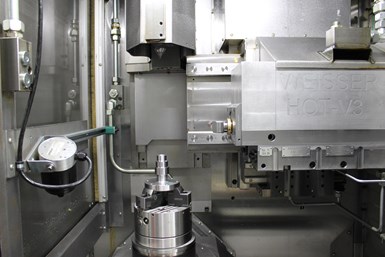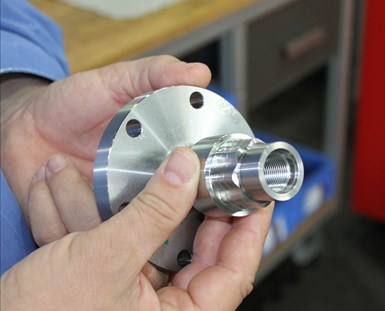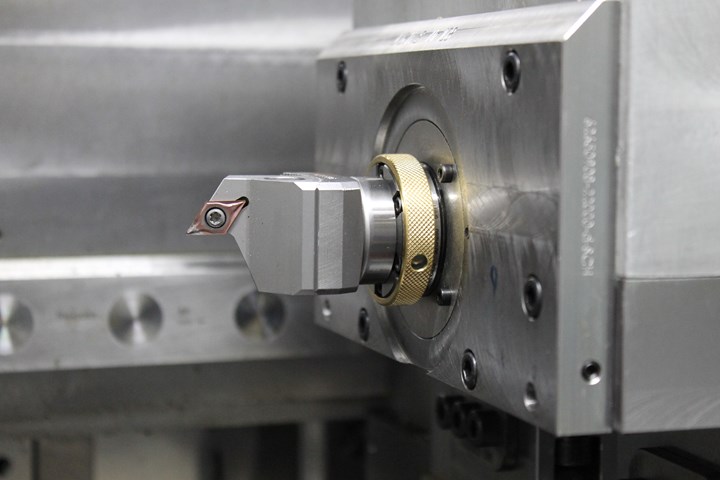
Weisser's Hyperspeed Oval Turning (HOT) "out-of-round" machining unit enables hard and soft machining of reciprocating pistons for combustion engines made of aluminum and steel, hardened camshafts, polygonal profiles or shapes, and automotive fuel pumps, among other applications.
Automotive transmissions continue to advance. They also continue to use spline and shrink-fit connections for internal shaft components. However, Reiner Jörg, head engineer of machine tool builder Weisser’s R&D department in southern Germany, says polygon couplings or polygon shaft-hub connections are a good alternative to these traditional connection methods for transmission components.
“Polygon couplings are nothing new,” he says. “Designed to eliminate common failure problems associated with splines and keyed shaft attachments, the general polygon system is a proven superior method for making demanding mechanical connections that are stronger, more precise and have a substantially longer service life, because effective load distribution virtually eliminates point contact, minimizing stress fatigue and distortion. The polygon has a greater capacity for torque than any other shaft attachment. The force transmission and load ratings are optimized and a shorter shaft connection can often be used and valuable space saved. Less accelerated mass in a smaller space such as gearboxes contributes to the aforementioned fuel efficiency.”
Nevertheless, he says car manufacturers have yet to adopt polygon couplings for their transmissions. One reason is that the parts are difficult to machine. However, Weisser’s out-of-round turning technology could change that by enabling manufacturers to turn finished polygonal shapes in one setup on one machine. Such capability can make out-of-round turning a more efficient alternative to the profile milling and grinding processes typically used to produce traditional automotive shaft-hub connections.
Since its introduction in 1993, out-of-round turning has been used for hard and soft machining of reciprocating pistons for combustion engines made of aluminum and steel, hardened camshafts, polygonal profiles or shapes, and automotive fuel pumps. Now, Weisser is working on several projects with original equipment manufacturers (OEMs) to demonstrate how wider adoption of this process could make it feasible to replace traditional shaft-hub connections with polygon couplings.

Polygon shafts are designed to eliminate common failure problems associated with splines and keyed shaft attachments. The polygon has a greater capacity for torque than any other shaft attachment. The force transmission and load ratings are optimized and a shorter shaft connection can often be used to save space.
For example, the company’s Hyperspeed Oval Turning (HOT) out-of-round machining system is a separate unit that integrates with the company’s Vertor vertical turning machine. Oval or out-of-round shapes are produced by the interaction of the workpiece spindle axis with the diameter-generating feed axis of the tool.
The tool cutting edge moves in the same direction of the X-axis and perpendicular to the workpiece spindle axis. The cutting edge can be positioned variably in this notional plane to produce radial and frontal contours or hemispherical out-of-roundness. Weisser uses linear drives rather than ballscrews to accelerate the oval turning units.
The power of the dynamic drive is partly required for the acceleration of the mass and partly required as the force acting on the tool cutting edge during machining. The cutting tool can be accelerated in a radial oscillating movement by as much as 130 Gs. This level of acceleration is so extreme, even for the latest Siemens and Bosch Rexroth CNCs, that most applications involve accelerations of only 30 to 90 Gs.
“For a given out-of-roundness, the maximum allowable rpm of the workpiece is related to the maximum acceleration of the tool bit, as produced by the oscillating drive. A nominal acceleration of 30 Gs facilitates the highest accuracy and the generation of a first-class surface finish,” Jörg says.

The movement of the tool’s cutting edge is in the direction of the X-axis and, therefore, perpendicular to the workpiece spindle axis. The cutting edge can be positioned variably in this notional plane so that radial and frontal contours or hemispherical out-of-roundness can be produced.
Despite the high nominal acceleration, special shock-absorbing properties are said to ensure precision by limiting the force exerted on the machine base structure. “Our system compensates acceleration forces by turning acceleration work into kinetic energy, so machine vibrations are eliminated and high surface qualities achieved,” Jörg explains. “Due to the integrated cutting force compensation, the net cutting forces (passive forces) can be almost entirely neutralized.”
One of Weisser’s customers manufactures polygonal cams in less than one minute in one setup and four turning passes, including face machining and chamfering operations. At 1,500 rpm, the out-of-round turning unit generates a feed rate of 0.1 mm per rotation and a cutting depth of 0.8 to 2 mm. The parts are finished with an accuracy of ±10 microns.
Another customer that has gone a step further than many international competitors has already integrated a polygon coupling into a newly developed gearbox, using Weisser’s HOT technology. “The customer replaced the spline shaft with a polygon shaft in the seventh gear, which reduced the shaft length from 20 to 12 mm since the polygon has a greater capacity for torque than any other shaft attachment,” Jörg says. “So, a shorter shaft connection can be used and valuable space saved.” The space savings helped optimize the transmission ratio of the first gear, which encountered fatigue problems with the original design.
Pushing its HOT technology for polygon shaft-hub connections, Weisser has so far sold around 100 machines with an integrated out-of-round turning unit. It is now offering its Vertor C vertical turning machine with an automatic toolchanger to enable even more flexible machining. According to Jörg, the achievable accuracy is currently limited by the capacity of the CNC. “If you run your machine at 1,800 rpm and want to machine your part with a resolution of one degree with our out-of-round turning unit, the controller has to handle 9,180 signals per second. We are talking about a resolution in the area of nanoseconds. That’s the limiting factor. But we are working on further limiting these system boundaries to machine at a micron tolerance level.”
Related Content
Video: Why a Production Machine Shop Started a Baseball Bat Company
A 153-year-old manufacturer of precision, metal pins recently started a side business creating custom wooden baseball bats. The reasoning behind establishing this new company is intriguing, as is how it has helped create a stronger bond with the local community.
Read MoreAn Automated Answer for Machining Ball Pins
This new vertical turning center with measurement and robotic automation processes is able to produce vehicle ball joint ball pins in 7 seconds.
Read MoreBoring Head Enables Sculpture Hardware to Be Machined on a Lathe
When small job shop Ansonia Manufacturing took on a tricky hardware component job for a “live” glass art sculpture, it realized a boring head would be needed to machine the part complete on its live-tool lathe.
Read MoreIn-Machine Probing Possibilities for VTLs
A manufacturer of vertical turning centers uses a “push/pull” optoelectronic probe with custom bracket to enable its machines to perform effective, in-process measurement of shafts and related automotive components.
Read MoreRead Next
Shop Turns to Vertical Turning for Small Batch Sizes
Vertical turning lathes are often used for large batch sizes, but a Swiss gear manufacturer is using the machines to produce small batch sizes of precision gears and transmission components.
Read MoreThe Upside of Vertical Turning
Vertical turning centers that use the main spindle to load and unload themselves are finding increasing acceptance as multitasking capabilities make them efficient processing centers for producing chucked parts.
Read More











.jpg;maxWidth=300;quality=90)








